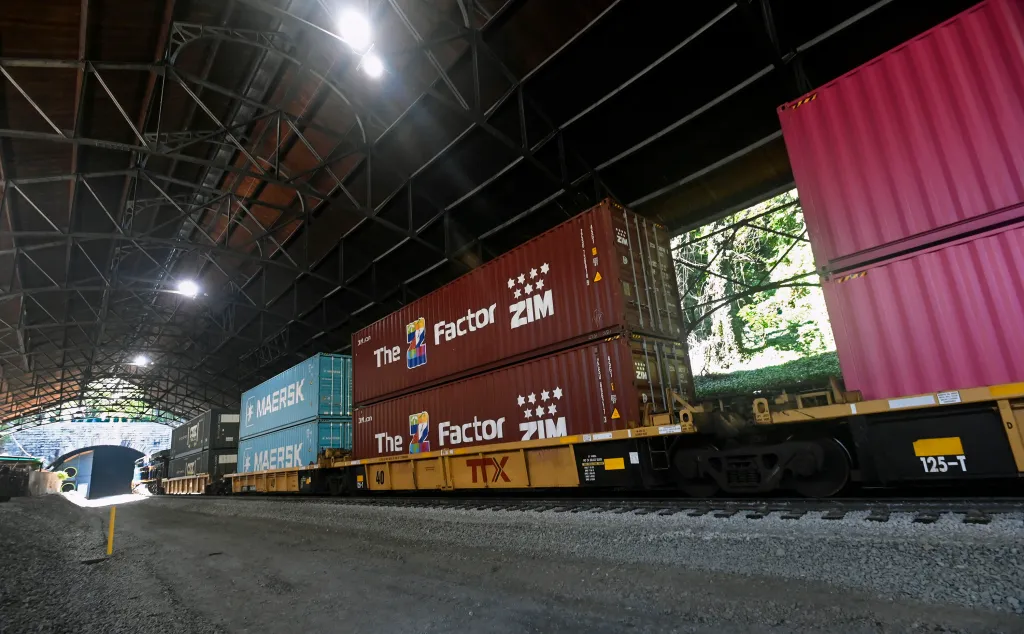
For decades, Baltimore’s Howard Street Tunnel has been both an asset and a chokehold. Built in 1895 by the B&O Railroad, it was once an engineering triumph; by the late 20th century, its low clearances kept double-stack trains from passing through, capping Baltimore’s competitiveness and straining America’s supply chain. The problem was obvious for generations — and now, at last, it has been fixed.
The Howard Street Tunnel has always been a direct rail artery through one of America’s historic industrial port cities. But for years, its 19.5-foot clearance blocked the standard of modern freight: double-stack containers. While rivals like Norfolk and New York advanced, Baltimore absorbed higher costs and slower service.
With the recent reopening, CSX has completed a $450 million expansion of the tunnel ahead of schedule. The solution was smart, not flashy: lower the track bed, notch the ceiling and clear nearby bridges to meet double-stack requirements — modernizing a 19th-century tunnel for 21st-century commerce.
It took decades of persistence to get here. Federal, state and local officials pieced together the support and funding to make it happen. Civic and port advocates called it the “last piece of the puzzle.”
Business organizations, including the Greater Baltimore Committee (GBC), kept the project on the agenda. That persistence has now been matched with real investment from CSX, the state of Maryland and federal partners — delivering an achievement Baltimore has chased for generations.
The payoff will be national. Double-stack service through Baltimore is expected to move 160,000 additional containers annually and generate more than 13,000 jobs. It will pull freight off crowded highways, reduce emissions along the I-95 corridor and give shippers faster, cheaper access to Midwest and inland markets. For the U.S. economy, it means a stronger, more resilient supply chain.
The timing could not be more critical. The collapse of the Francis Scott Key Bridge in 2024 reminded the nation how essential Baltimore’s infrastructure is to industrial America. When the bridge fell, it disrupted the entire supply chain economy — slowing port operations, diverting freight and shocking businesses across the region. Just as important, it upended daily life for Key Bridge communities that depend on that connection for work, schools and commerce.
The Port of Baltimore anchors America’s energy and manufacturing supply chains — moving Pennsylvania and West Virginia coal exports, 80% of the nation’s tin imports, and leading the country in automobiles and farm equipment. Rebuilding the Key Bridge, alongside the tunnel’s reopening, restores the backbone of a port the nation leans on every day. At the same time, the $1 billion Sparrows Point Container Terminal is one of the largest port expansions on the East Coast. It will attract new shipping lines, create thousands of jobs and firmly establish Baltimore among the nation’s leading ports.
Land supply is the other constraint. GBC’s 10-Year Plan identified the shortage of modern industrial sites early and set a clear agenda: unlock underutilized land, accelerate redevelopment and prepare large-scale parcels for growth. Maryland’s new Business Ready Sites program is part of the answer, preparing the next wave of build-ready locations — from advanced manufacturing in Baltimore City to large-scale capacity in surrounding counties. Longer-cycle opportunities like the Curtis Bay Depot redevelopment, combined with recent and potential cargo investments at BWI Marshall Airport, will add capacity and complement port rail upgrades.
The competition will not wait. Savannah is pouring nearly $4 billion into terminals, rail and gates. Norfolk has long enjoyed unconstrained double-stack access through Virginia. Without the Howard Street Tunnel expansion, Baltimore risked conceding discretionary cargo — and the jobs and tax base that follow — to faster-growing southern ports. With it, we’re back in the fight for market share and positioned to win projects that value speed, reliability and inland reach.
It shouldn’t have taken this long. Business and civic leaders kept pressing, and today that persistence is finally rewarded.
Baltimore’s infrastructure has never been just Baltimore’s. It has always carried national weight. Reopening the Howard Street Tunnel and rebuilding the Key Bridge will revitalize one of America’s great industrial economies and strengthen the East Coast trade corridor stretching from Washington through New York and into the Midwest. That is not simply a victory for Baltimore — it is a win for a country that needs its ports and railroads to run on time.
The birthplace of American railroading just secured its future.
Mark Anthony Thomas is the president and CEO of the Greater Baltimore Committee.